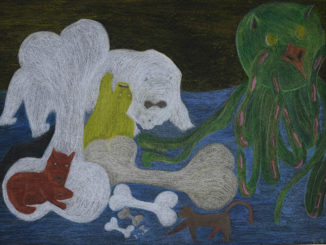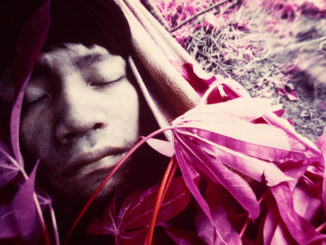 From the Whitney Biennial to museum and gallery appearances across the country to booth stops at international art fairs, Miami homeboy Gispert has exported an urban, Cuban-American imagery throughout the world.
From the Whitney Biennial to museum and gallery appearances across the country to booth stops at international art fairs, Miami homeboy Gispert has exported an urban, Cuban-American imagery throughout the world.
Miami has had the pleasure again to be smothered with the eye-and-ear-catching, mind-bending art of Luis Gispert. His 28-minute movie Smother unspoiled in a back room of Fred Snitzer’s gallery during Art Basel, along with large-scale photography and sculpture displayed in pink-padded space up front. With a freaky, jaw-dropping movie-ending and gorgeous visuals from front to back, the exhibit was classic Gispert. Many would recognize it as such because, needless to say, many have seen his work. From the Whitney Biennial to museum and gallery appearances across the country to booth stops at international art fairs, Miami homeboy Gispert has exported an urban, Cuban-American imagery throughout the world. And his imagery is unmistakable. In photographs: those hoochy cheerleaders set against brilliant color or families draped in baroque outfits and surroundings; in sculpture: attention – and wall-grabbing sound pieces; in film: bizarre and vividly drawn dreamscapes. And playing a starring role in many of these pieces – boom boxes.
Much has been said about Gispert’s melding of hip-hop and Latino-American cultures; yet his art also reflects a common heritage grounded in a 20th-century Americana childhood.
Back in the darkened room at Snitzer’s, in the movie that first “premiered” last year at New York’s prestigious Mary Boone gallery (and will show again at MoCA’s Goldman Warehouse in the spring), all of those influences leap off the screen.
A young Latin boy wonders around a world populated with pink flamingos, velvet curtains, cut mirrors, and boom boxes. He lives in a “narco-nouveau riche mansion,” inherited from his dead drug-dealing father, with his obsessive mother. It’s very Miami – specifically, very Cocaine Cowboys 1980s Miami. The Miami of Gispert’s childhood. And it’s also a dream, or more accurately, a surreal nightmare. The boy – caught between childhood and adulthood – still wets his pants; his mother still smothers him, and after a dream about giants, demands that he never grows up.
It is somewhat autobiographical, according to the artist. “With the last few works I’ve tried to mine memories, experiences I had before I knew what ‘art’ was,” explains Gispert, from a location in Ohio where he is shooting a film. “Hence before college – I grew up between Washington Heights (New York), Little Havana and South Miami.”
When the “bad man” shows up in Smother, the pop-cultural references become glaringly clear: it’s Steven Bauer, he of Scarface fame (who was born Esteban Ernesto Echevarria in Cuba and also starred in Que Pasa U.S.A.?). Yes, this is in part the violent pastel world of that iconic movie, which was set in Miami but gained a cult following among America’s youth and in the hip-hop world – the ultimate meshing of Gispert’s influences. “Scarface is a seminal signifier for hip hop,” says Gispert. “The list is endless of songs that reference the film. I saw the film at age 12 and it scared the shit out of me. That was the first time I experienced the power of cinema, and things have never been the same.”
And like that movie, his movie gets bloody. The boy turns into a German shepherd (Gispert’s dog as a child) and then Steven Bauer boils him to death, and then the dog turns into a, what else?, boom box. And then the box with the soul of the boy is taken away by Rastafarians, freeing him at last from mother. It also may have freed the artist from his own iconic imagery. “I think I killed the boom box with the Smother film,” he suggests. “I don’t think it will be showing up again. The boom box represents a longing for innocence. And for early hip-hop culture.”
{mospagebreak}
The narrative aside, Smother is also absolutely mesmerizing and beautiful, with its super soundtrack (courtesy of Miami’s Phoenicia), Technicolor color-scheme and intense visuals – all lush and disturbing. After all, unlike Scarface, this is a lovingly detailed piece of art.
The same of which is true with the pieces in the front of the gallery. Like the gorgeous C-prints of tricked-out truck interiors with views of an urban landscape (or war zone) through the windshields, such as Humvee. These photos are hanging on pink walls that arise from pink floors, a strange sensory experience when you walk into the gallery.
Set up on the floors are speakers (a close relative, really, to the boom box) with pink hearts on them. They are coupled, with titles such as Like Ships in the Night and Chusma (gossip). Again, this front room is both lush and disturbing, where war zones collide with fluffy pink kitsch. Less obvious in this show is Gispert’s visual exploration of the idea that kitsch, violence and poverty are part of the immigrant and urban experience, which is more apparent in earlier photography.
For instance, his cheerleader series that plumbed the bling culture of the gansta-rap genre. The girls sport ultra-long bejeweled fingernails or gold medallion necklaces – emblematic of over-the-top ghetto-fabulous style, and of nouveau-riche culture in general. To some it is tawdry and laughable, which can also be translated as “ethnic” and low-class. A similar line is followed in his family series, where Cuban-American family members are literally dressed in baroque fashion from the 17th century, mimicking the décor style found in many immigrant Latino homes. In fact, a visit to an Asian-American home, or a Polish immigrant home, might reveal a similar aesthetic.
Depending on the beholder, it’s an attempt to replicate the grandeur of a motherland, or a cheap (read classless) take on glamour.
The artist links bling and baroque as similar stylistic expressions. In one great print, Bedroom, 2003, a woman wearing an ornate gown and veil sits on a bed surrounded by religious knick-knacks, while a boom box floats in front of her. The artist once told Style.com, “bling-like fashion is mostly surface – a not very interesting, one-dimensional signifier, but the psychology or socioeconomic reality of the wearer is fascinating.”
Some such wearers are likely to be on display in Miami with the Goldman Warehouse show, which will be a retrospective of Gispert’s work going back to 2002. It will be a good time to look back at his work, as the artist says he’s closing some of these chapters.
“I’m moving away from big art projects that take two-to-three years to execute. I’m returning to short videos that are more immediate. I will be making a new series of sculptures not connected to this recent work.” And he is in the process of developing a narrative feature film “which is separate from art endeavors.”
So in the meantime, for anyone who missed Smother; or the sculpture that seemed to break through the wall of the Whitney Museum at Altria in 2004 (and which emitted hip-hop when you sat on it); or the prints such as the one with toddlers in a garishly baroque room encircling a totem boom box, Tower, 2003 – MoCA will deliver another chance to experience Luis Gispert’s strange, superbly crafted, multi-pronged, multi-cultural universe. Which really isn’t so strange after all. On view at the Museum of Contemporary Art’s Goldman Warehouse from May 11th through June 27th: the first major solo museum exhibition of Luis Gispert, featuring works from 2002 through the present, including new photographic work, film, sculpture and site-specific multi-media installation.



Be the first to comment